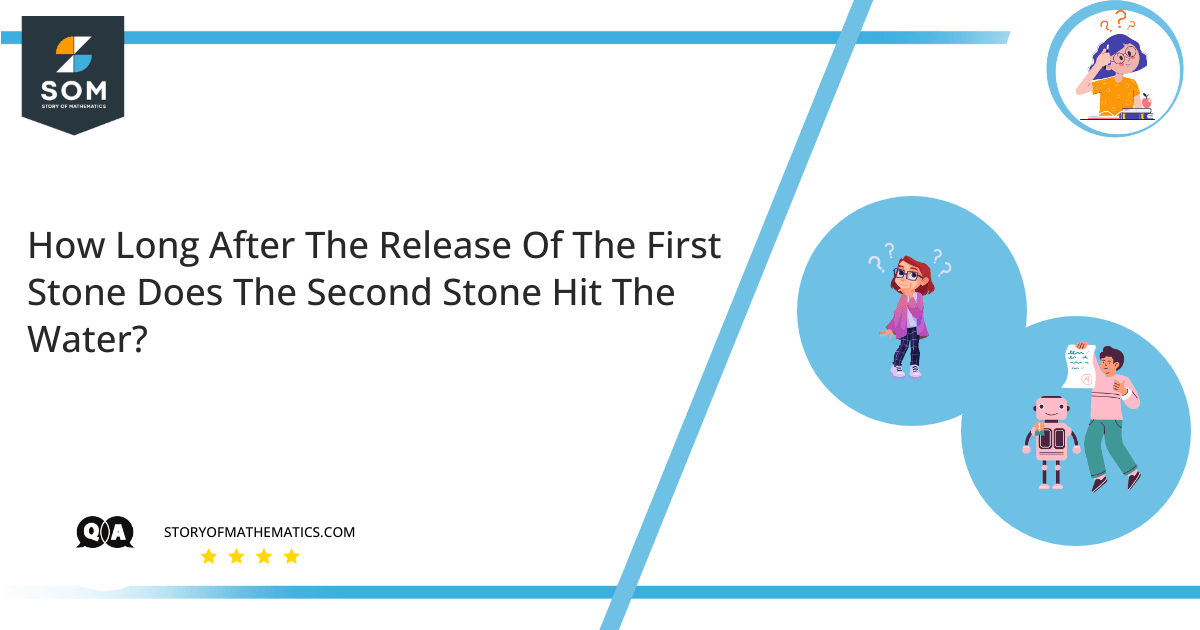
- How long after the release of the first stone does the second stone hit the water?
- What was the initial speed of the second stone?
- What is the speed of each stone as it hits the water?
This question aims to find the time of the stone as it hits the water, the initial speed of the second stone, and the final speed of both stones as they hit the water.
The basic concepts needed to understand and solve this problem are equations of motion, gravitational acceleration, and initial and final velocities of an object during vertical fall.
Expert Answer
We are taking the initial point at the cliff as the starting point, hence the final height will be at the water surface and the initial height will be at the cliff. Also, the downward motion will be taken as positive.
The given information regarding this problem is given as follows:
\[ The\ Initial\ Velocity\ of\ the\ First\ Stone\ v_i\ =\ 2.5\ m/s \]
\[ The\ Final\ Height\ h_f\ =\ 70\ m \]
\[ The\ Initial\ Height\ h_i\ =\ 0\ m \]
\[ The\ Acceleration\ due\ to\ Gravity\ g\ =\ 9.8\ m/s^2 \]
a) To calculate the time the second stone took to hit the water after the first stone, we will use the equation of motion, which is given as:
\[ h_f = h_i + v_it + \dfrac{1}{2} at^2 \]
Substituting the values, we get:
\[ 70 = 0 + 2.5t + \dfrac{1}{2} (9.8) t^2 \]
\[ 4.9t^2 + 2.5t – 70 = 0 \]
By using the quadratic formula, we can calculate the value of $t$, which is calculated to be:
\[ t_1 = 3.53\ s \]
Ignoring the negative value of $t$ as time is always positive.
The second stone was released $1.2s$ after the first stone was released, but reached the water at the same time. So the time the second stone took to reach the water is given as:
\[ t_2 = 3.53\ -\ 1.2 \]
\[ t_2 = 2.33\ s \]
b) To calculate the initial velocity of the second stone, we can use the same equation. The initial velocity can be calculated as:
\[ h_f = h_i + v_it_2 + \dfrac{1}{2} gt_{2}^{2} \]
Substituting the values, we get:
\[ 70 = 0 + v_{i2} (2.33) + (0.5 \times 9.8 \times (2.33)^2 \]
\[ v_{i2} = \dfrac{70 – 26.6} {2.33} \]
\[ v_{i2} = \dfrac{43.4}{2.33} \]
\[ v_{i2} = 18.63\ m/s \]
c) To calculate the final velocities of both stones, we can use the following equation of motion:
\[ v_f = v_i + gt \]
The final velocity of the first stone is given as:
\[ v_{f1} = 2.5 + 9.8 \times 3.53 \]
\[ v_{f1} = 37.1\ m/s \]
The final velocity of the second stone is given as:
\[ v_{f2} = 18.63 + 9.8 \times 2.33 \]
\[ v_{f2} = 41.5\ m/s \]
Numerical Results
a) The total time the second stone took to hit the water:
\[ t_2 = 2.33\ s \]
b) The initial velocity of the second stone is calculated as:
\[ v_{i2} = 18.63\ m/s \]
c) The final velocities of both stones are calculated as:
\[ v_{f1} = 37.1\ m/s \hspace{0.6in} v_{f2} = 41.5\ m/s \]
Example
The initial velocity of an object is $2m/s$ and it took the object $5s$ to reach the ground. Find its final velocity.
As the object is falling, we can take the acceleration $a$ to be the gravitational acceleration $g$. By using the first equation of motion, we can calculate the final velocity without knowing the total height.
\[ v_f = v_i + gt \]
\[ v_f = 2 + 9.8 \times 5 \]
\[ v_f = 51\ m/s \]
The final velocity of the object is calculated to be $51 m/s$.
